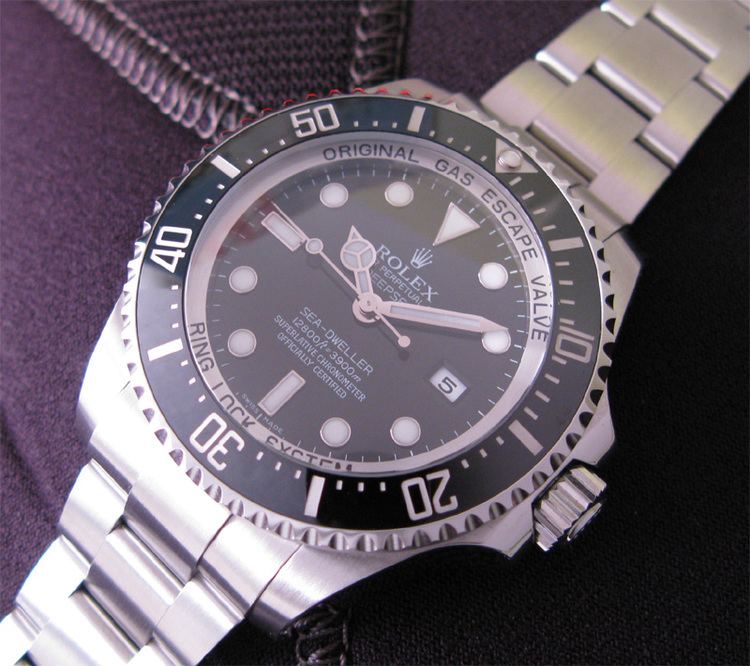 | ||
The Rolex Oyster Perpetual Date Sea-Dweller is a line of diver's watches manufactured by Rolex, with an underwater diving depth rating of 610 metres (2,000 ft) for the vintage models and up to 3,900 metres (12,800 ft) for the most recent Sea-Dweller DEEPSEA model.
Contents
History
During the 1960s, the needs of professional divers working at great depths led to the development of the first 'ultra water resistant' tool watches designed for conducting safe diving operations at 300 m+ (1,000 ft+) depths.
The Rolex Oyster Perpetual Sea-Dweller Submariner 2000 (2000 ft = 610 m) that became available in 1967 was developed from the Submariner for the Comex S.A. industrial deep-sea diving company by increasing crystal thickness and was produced in several variations. It had a depth rating of 610 metres (2,000 ft) and its Rolex reference number is 1665.
Most Sea-Dweller watches incorporate a helium escape valve for saturation diving. Early Sea-Dwellers, however, did not always have the valve. The model is also distinguished by the absence of the date magnifier ("cyclops") present on most other Rolex models. The Sea-Dweller diving watch range has been standard issue for Comex divers since 1977.
The Sea-Dweller Submariner 2000 watches have two red text lines on the watch dial, which led to an unofficial "Double Red" designation by watch collectors.
The Sea-Dweller Submariner 2000 models were succeeded by the Rolex Oyster Perpetual Sea-Dweller 4000 (4000 ft = 1220 m) model, with an increased depth rating to 1,220 metres (4,000 ft). The last Comex Sea-Dweller 4000 Rolex reference number is 16600. This watch was issued to Comex divers since 1992.
Several semi-custom production runs of Sea-Dweller Submariner 2000 and 4000 models were produced with and without helium escape valves and differing watch dial patterns for the Comex S.A. company. These variants sometimes also had differing Rolex reference numbers. Some of these non-standard Sea-Dweller watches had the Comex S.A. logo depicted on the watch dial, which led to an unofficial "COMEX watches" designation by collectors. These watches were either issued to Comex staff members or were given as business gifts.
At the BaselWorld watch and jewellery show 2008, Rolex introduced an updated Sea-Dweller model named the Rolex Oyster Perpetual Date Sea-Dweller DEEPSEA. Its reference number is 116660. With an official depth rating of 3,900 metres (12,800 ft), the Sea-Dweller DEEPSEA represented in its launch year the most water resistant mechanical watch in serial production. To obtain this official depth rating, the Sea-Dweller DEEPSEA is tested to a depth of 4,875 metres (15,994 ft) to offer the 25% safety reserve required by the ISO 6425 divers' watches standard. To test the water resistance of the Sea-Dweller DEEPSEA, Rolex uses testing equipment developed for them by Comex. Normal surface air filled watch cases and crystals designed for extreme depths must be large to cope with the water pressure. The Rolex Sea-Dweller DEEPSEA watch case has a diameter of 44.0 mm (1.73 in) mm and a thickness of 17.7 mm (0.70 in) (domed crystal thickness 5.5 mm (0.22 in)), and the case and bracelet weigh 212 g (7.5 oz).
Diving records
The design and actual availability of diving watches certified for more than 1,000 m (3,281 ft) is not solely explicable by practical diving needs.
The diving depth record for actual offshore diving was achieved in 1988 by a team of professional divers of the Comex S.A. industrial deep-sea diving company performing pipe line connection exercises at a depth of 534 metres (1,752 ft) of seawater (msw) in the Mediterranean Sea. They wore Rolex Sea-Dwellers.
In 1992, Comex diver Theo Mavrostomos achieved a record of 701 metres (2,300 ft) of seawater (msw) in an onshore hyperbaric chamber. He took 43 days to complete the dive. The watch used during this scientific record dive, where a hydrogen-helium-oxygen (hydreliox) gas mixture was used as breathing gas, was a Rolex Sea-Dweller 16600 with a 1,220 m (4,000 ft) depth rating. Rolex used this achievement in advertising campaigns.
The complexity, medical problems and physiological limits, such as those imposed by high pressure nervous syndrome, the accompanying high costs of professional saturation diving to extreme depths and the development of deep water atmospheric diving suits and remotely operated underwater vehicles in offshore oilfield drilling and production effectively ended the need for ever deeper, non-atmospheric manned intervention in the ocean. These practical factors make watch depth ratings of more than 1,000 m (3,281 ft) marketing curiosities.
Experimental Sea-Dweller DEEPSEA CHALLENGE watch
In late March 2012, Rolex announced that a new prototype diving watch was developed and is part of the Rolex supported attempt to dive the DSV Deepsea Challenger to the bottom of the Challenger Deep, the deepest surveyed point in the oceans. On 26 March 2012 the DSV Deepsea Challenger carried a Rolex Oyster Perpetual Date Sea-Dweller DEEPSEA CHALLENGE prototype diving watch strapped to its manipulator arm to a depth of 10,898.4 metres (35,756 ft) of seawater (msw). The experimental Sea-Dweller DEEPSEA CHALLENGE watch is designed to be waterproof up to 12,000 metres (39,370 ft). According to the pilot of the DSV Deepsea Challenger, James Cameron, the "Rolex Deepsea Challenge was the reliable companion throughout the dive; it was visible on the sub's manipulator arm and working precisely at 10,898 meters down at the bottom of the Challenger Deep." The normal surface air filled watch case has a diameter of 51.4 mm (2.02 in) and a thickness of 28.5 mm (1.12 in) (domed synthetic sapphire crystal 14.3 mm (0.56 in)) to cope with the water pressure at the deepest surveyed point in the oceans.
